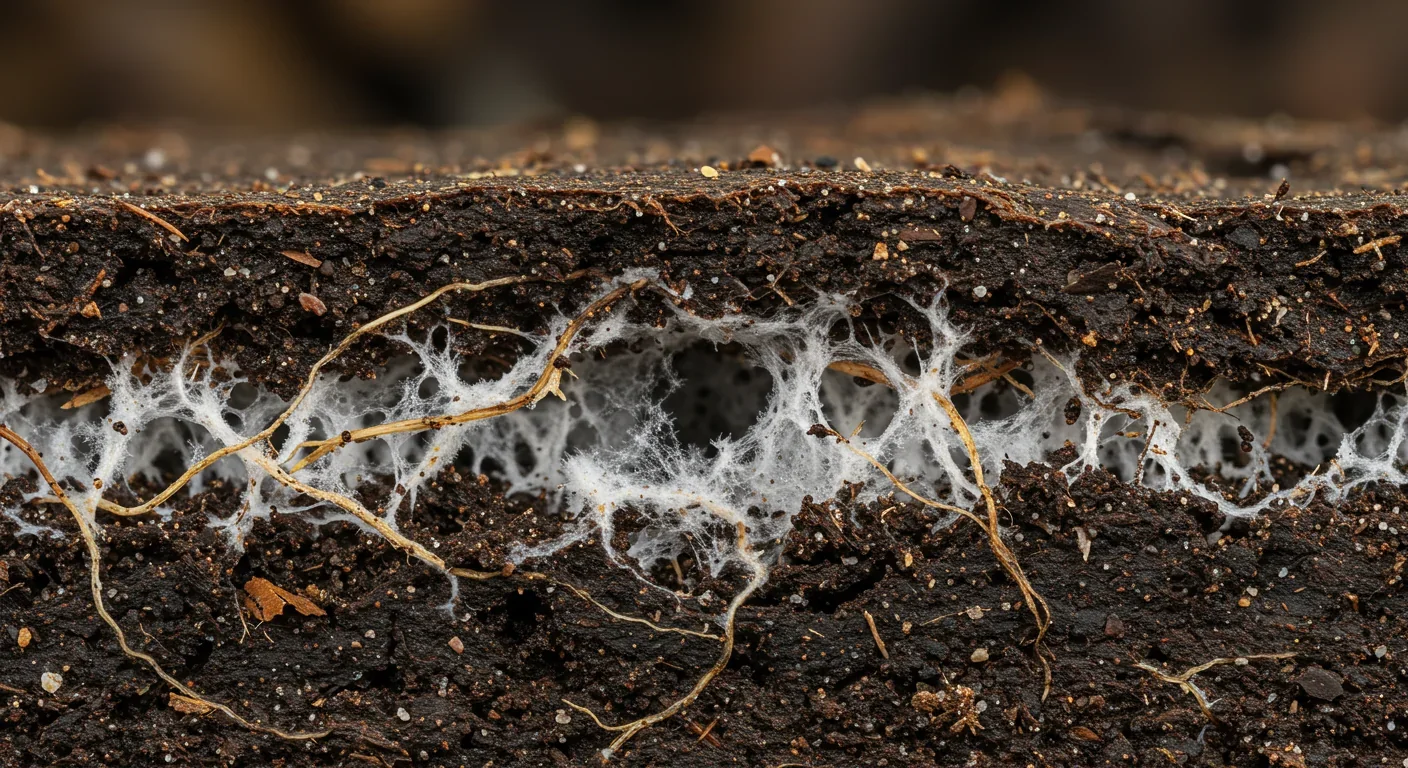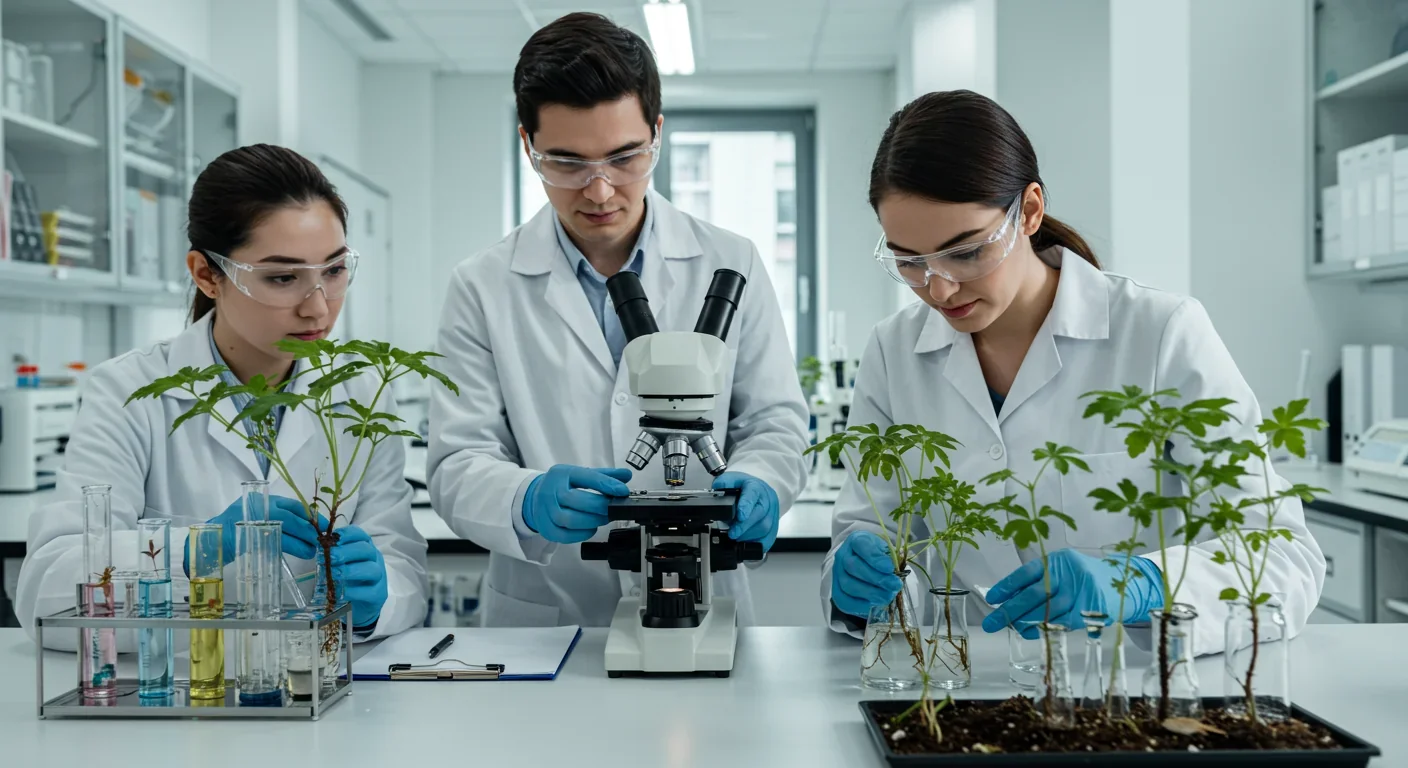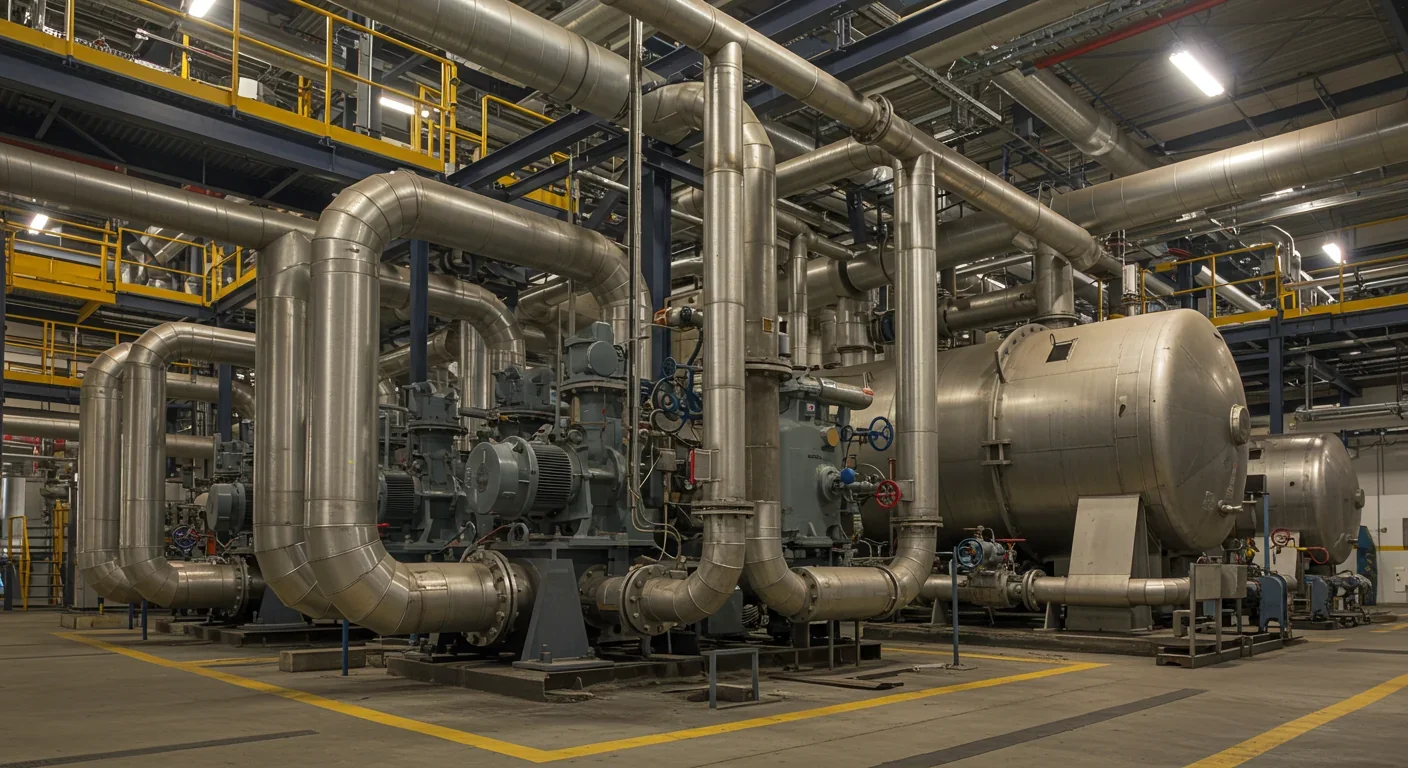How Soft Corals Weaponize Their Symbiotic Algae

TL;DR: Plants and fungi run underground commodity markets, trading carbon for nutrients through mycorrhizal networks. These ancient trading systems shape ecosystems and offer sustainable solutions for agriculture and forestry.
While stock exchanges buzz with frantic trading above ground, an ancient marketplace operates silently beneath every forest, farm, and garden you've ever walked through. This underground economy has been running for over 400 million years, making Wall Street look like a lemonade stand experiment. Plants and fungi negotiate billion-year-old commodity exchanges with precision that would make any economist envious.

The basic transaction is elegantly simple. Plants allocate 5 to 20 percent of their total carbon uptake to mycorrhizal fungi living on their roots. In return, these fungi deliver water, nitrogen, phosphorus, and other essential minerals that plants struggle to access on their own. It's a carbon-for-nutrient marketplace operating at microscopic scales across virtually every terrestrial ecosystem on Earth.
The numbers tell a compelling story. In some ecosystems, the biomass of mycorrhizal fungi rivals that of fine roots themselves. In Swedish forests, these fungi hold 50 to 70 percent of the total carbon stored in leaf litter and soil. We're not talking about a minor biological interaction. This is a fundamental restructuring of how nutrients and energy flow through ecosystems.
Not all mycorrhizal partnerships follow the same business model. Arbuscular mycorrhizal (AM) fungi penetrate plant root cells directly, creating intimate trading posts where nutrients change hands at the cellular level. These fungi associate with roughly 80 percent of plant species, making them the dominant players in agriculture and grasslands.
Ectomycorrhizal (ECM) fungi take a different approach. They surround root cells without penetrating them, forming a sheath and a network called the Hartig net between root cells. These fungi dominate in temperate and boreal forests, partnering primarily with trees like pines, oaks, and beeches. Recent research shows that AM and ECM fungi respond differently to phosphorus availability, suggesting they've evolved distinct economic strategies.
ECM trees in phosphorus-limited soils show higher fungal colonization and greater mycorrhizal dependence, while AM trees maintain more consistent trading relationships regardless of phosphorus levels.
ECM trees in phosphorus-limited soils show higher fungal colonization and greater mycorrhizal dependence. AM trees, meanwhile, maintain more consistent trading relationships regardless of phosphorus levels. Think of it as the difference between specialized boutique traders and generalist market makers.
Plants aren't passive participants in these exchanges. They actively regulate carbon allocation to fungi based on the quality of service received. When fungi deliver scarce nutrients, plants increase carbon payments. When fungal performance drops, plants reduce the flow of sugars.
This creates a dynamic pricing mechanism. In phosphorus-poor soils, the exchange rate shifts in favor of fungi because their service becomes more valuable. In nitrogen-limited environments, fungi that efficiently deliver nitrogen receive premium carbon payments. The market adjusts to local conditions.
Plants also diversify their fungal portfolios. A single tree might simultaneously host dozens of fungal species, each with different capabilities. Some excel at phosphorus acquisition, others at nitrogen, and still others at accessing water or micronutrients. By maintaining multiple partnerships, plants hedge against market failures.

Individual plant-fungus partnerships are impressive enough, but the real complexity emerges when fungi connect multiple plants. A single fungal network can link dozens of plants, creating what ecologists call the Common Mycelial Network (CMN).
These networks enable resource redistribution across the connected plants. Carbon fixed by sun-drenched canopy trees can flow through fungal intermediaries to shaded seedlings. Nutrients acquired by deep-rooted adults can reach shallow-rooted juveniles. The system creates opportunities for both cooperation and exploitation.
But here's where the economic metaphor gets really interesting. These networks aren't necessarily altruistic. Fungi may preferentially supply nutrients to plants offering better carbon deals. Mother trees might or might not be actively supporting their offspring. The jury is still out on how much intentional cooperation versus simple market mechanics drives these patterns.
"These networks aren't necessarily altruistic. Fungi may preferentially supply nutrients to plants offering better carbon deals, suggesting market mechanics rather than familial cooperation."
— Research on Common Mycelial Networks
Like any sophisticated market, the mycorrhizal economy attracts cheaters. Some plants have evolved to take nutrients without paying full price. Myco-heterotrophic plants have abandoned photosynthesis entirely, tapping into fungal networks to steal carbon that other plants produced. They're the shoplifters of the underground economy.
Indian pipe and ghost orchid are famous examples. These pale, ghostly plants contain no chlorophyll. Instead, they hijack mycorrhizal networks, intercepting carbon flowing from photosynthetic trees to fungi. From an economic perspective, they're running a sophisticated arbitrage scheme.
Plants can also punish underperforming fungal partners. When experiments block nutrient transfer from specific fungal associates, plants reduce carbon allocation to those fungi while maintaining or increasing support for better performers. It's a market-based enforcement mechanism that doesn't require consciousness or intention.
Fungi aren't passive victims either. Some fungal species can manipulate plant defenses or alter plant carbon allocation in their favor. Others form cartels, dominating the root systems of certain plant species and excluding competitors. Market power operates below ground just as it does above.

Not all plants rely equally on mycorrhizal markets. Ecologists now talk about a root economics spectrum that ranges from "do-it-yourself" to "outsourcing" strategies.
At one extreme sit plants like Brassicas (broccoli, cabbage, mustards) that lost their ability to form mycorrhizal associations during evolution. These plants produce extensive fine roots and rapid nutrient uptake systems. They're vertically integrated operations handling their own supply chain.
At the other extreme are highly mycorrhizal-dependent species that invest minimal resources in root production and instead funnel massive amounts of carbon to fungal partners. These are the extreme outsourcers, building thin root systems and letting fungi handle logistics.
Most plants fall somewhere in between, adjusting their strategy based on soil conditions, competition, and nutrient availability. In nutrient-rich soils, DIY strategies often win. In poor soils, outsourcing to fungi makes more economic sense because fungi can explore soil volumes that roots cannot cost-effectively reach.
Research on subtropical forest succession shows that early successional species tend toward DIY strategies while late successional species lean more on fungal partnerships. As ecosystems mature and competition intensifies, the advantages of mycorrhizal networking apparently increase.
Rising CO₂ levels are affecting these underground markets in complex ways. Higher atmospheric carbon means plants produce more sugars through photosynthesis, potentially giving them greater purchasing power in mycorrhizal exchanges. But the reality is messier.
Studies show that elevated CO₂ increases fungal abundance in some systems, leading to higher carbon allocation to fungi. However, this increased fungal activity can also accelerate soil carbon decomposition through a process called priming. In some forests, more carbon goes underground only to be respired back to the atmosphere faster.
Temperature changes add another layer of complexity. Many mycorrhizal fungi have temperature optima, and warming soils can disrupt established partnerships. Arbuscular mycorrhizal fungi seem particularly sensitive to heat stress, though species vary widely in their thermal tolerance.
During severe drought, plants lose their water procurement specialists precisely when they're needed most, creating a critical vulnerability in the underground trading system.
Drought is perhaps the most direct threat. Mycorrhizal networks help plants access water during dry periods, but severe or prolonged drought can kill the fungi themselves. When fungal partners die, plants lose their water procurement specialists precisely when they're needed most.
Global mapping efforts reveal that mycorrhizal fungi distributions correlate with climate zones, but large areas hosting critical fungal populations lack protection. As climate zones shift, the trading networks that underpin ecosystem function may struggle to keep pace.

Farmers and agronomists are increasingly recognizing mycorrhizal fungi as essential infrastructure rather than optional add-ons. The implications for agriculture are substantial.
Inoculating crops with beneficial mycorrhizal fungi can reduce fertilizer requirements by improving nutrient uptake efficiency. Field trials show that mycorrhizal inoculation can boost phosphorus uptake by 25 to 50 percent in some crops. That's a significant reduction in fertilizer costs and environmental pollution.
The fungi also improve soil structure. As they grow, mycorrhizal fungi produce proteins like glomalin that bind soil particles into stable aggregates. This improves water infiltration, reduces erosion, and creates better growing conditions. Research on mango orchards shows that mycorrhizal fungi can regulate bacterial community structures, enhancing overall soil fertility.
Drought resilience is another major benefit. Plants with well-developed mycorrhizal networks maintain better water status during dry periods. Studies across multiple crops including rice, sesame, sorghum, and others demonstrate consistent growth promotion and stress tolerance improvements from mycorrhizal inoculation.
The catch is that intensive agriculture often disrupts these natural partnerships. Heavy tillage physically shreds fungal networks. Excessive fertilizer application can cause plants to reduce mycorrhizal investments because nutrients are already readily available. High-density monocultures may lack the plant diversity needed to support diverse fungal communities.
Regenerative agriculture practices like reduced tillage, cover cropping, and diverse crop rotations aim to maintain mycorrhizal infrastructure. The economic logic is compelling: why pay for expensive fertilizers when you can maintain the underground trading network that delivers nutrients more efficiently?
In forestry, mycorrhizal networks are now recognized as critical infrastructure that shouldn't be casually destroyed. Clear-cutting not only removes trees but also eliminates the fungal networks that surviving seedlings depend on. Recovery can take years.
Some foresters now advocate for retention harvesting that leaves 10 to 30 percent of trees standing. These retained trees maintain fungal networks that can support regeneration. The approach recognizes that forests are more than collections of individual trees. They're integrated trading systems where the underground market infrastructure has value.
Mycorrhizal networks may also help explain forest resilience to disturbances. After fires, windstorms, or pest outbreaks, surviving mycorrhizal networks can accelerate recovery by supporting young trees. The fungal infrastructure remains operational even when aboveground structures are destroyed.
Forest managers are also considering mycorrhizal partnerships in species selection for reforestation. Matching tree species to appropriate fungal partners can improve plantation success, particularly in degraded soils where natural fungal communities are depleted.
"Forests are more than collections of individual trees. They're integrated trading systems where the underground market infrastructure has value."
— Forest Ecology Research

Despite decades of research, major questions remain about how these underground markets actually function. The concept of the "wood wide web" has captured public imagination, but scientists debate how much resource sharing really occurs through common mycelial networks.
Critics point out that carbon transfer between plants through fungal networks is often small and inconsistent. Just because carbon can flow between connected plants doesn't mean it flows in ecologically significant quantities under natural conditions. Lab experiments showing resource sharing may not reflect what happens in complex forest ecosystems.
The question of plant agency is particularly contentious. When nutrients flow from mature trees to seedlings, is this active support or simply fungal market mechanics? Mycorrhizal fungi might deliver nutrients wherever plants offer the best carbon returns, regardless of kinship or species identity. Attributing intentionality to plants or fungi requires evidence we don't yet have.
There's also debate about the evolutionary stability of these partnerships. If plants can cheat and fungi can cheat, why hasn't cheating become universal? Various mechanisms for maintaining cooperation have been proposed including partner choice, sanctions against cheaters, and spatial structure that limits cheater spread but research continues on which mechanisms dominate.
The complexity of natural systems makes definitive answers difficult. In real forests, dozens of plant species interact with hundreds of fungal species across heterogeneous soil conditions. Teasing apart cause and effect in these tangled webs requires sophisticated experiments and long-term observations.
Perhaps the most philosophically interesting aspect of mycorrhizal networks is what they reveal about self-organization. These underground markets operate without central planning, conscious thought, or verbal communication. They emerge from simple feedback loops: plants that pay more get better service, fungi that deliver more nutrients receive more carbon.
Market-like behavior doesn't require markets in the human sense. No plant or fungus understands economic theory, yet they've evolved trading systems that respond to supply, demand, scarcity, and competition. The mechanisms are molecular and cellular rather than psychological and social, but the outcomes resemble the resource allocation systems we associate with market economies.
This suggests that economic principles might be more fundamental than we realized. Whenever entities exchange resources and can vary their contribution based on returns received, market-like dynamics can emerge. The sophistication of mycorrhizal trading systems evolved not through intelligence but through billions of years of natural selection favoring organisms that traded effectively.
Understanding these systems better could inform human economics. If plants and fungi have been running sophisticated commodity exchanges for 400 million years, maybe there are lessons about sustainable resource sharing, risk management, and cooperation under competition that apply beyond biology.
As humanity faces interconnected challenges of food security, climate change, and ecosystem degradation, the underground economy of mycorrhizal networks offers both inspiration and practical tools.
The inspiration comes from recognizing that cooperation and resource sharing can emerge through market mechanisms without requiring altruism or central control. Plants and fungi aren't friends. They're trading partners maintaining relationships through mutual benefit. That's a more robust foundation than good intentions.
The practical tools come from applying mycorrhizal principles to agriculture and land management. Building and maintaining fungal infrastructure could reduce our dependence on synthetic fertilizers, improve soil health, and increase crop resilience to climate stress. These aren't speculative future technologies. They're time-tested systems we're only now learning to stop destroying.
Global research efforts are mapping mycorrhizal distributions and understanding how these networks respond to environmental gradients. As we understand more about which fungi thrive where and why, we can make better decisions about conservation, restoration, and agricultural management.
The underground economy has been operating successfully longer than flowering plants have existed, longer than trees have grown on land, longer than animals have walked on Earth. While we've been trading for mere thousands of years, plants and fungi have been perfecting their commodity exchanges for hundreds of millions.
Walking through a forest or across a farm field, you're traveling above one of nature's most sophisticated marketplaces. Beneath your feet, trillions of microscopic transactions occur every second. Carbon for nitrogen, sugars for phosphorus, photosynthetic products for water and minerals. No stock exchange necessary. No currency besides the molecules of life. Just an ancient economy, still running, still evolving, still teaching us that markets can emerge wherever resources need to be allocated and partners need to be chosen.
The underground trading networks that have sustained terrestrial life for nearly half a billion years now depend, in part, on choices we make about agriculture, forestry, and land use. Understanding how these markets function isn't just fascinating biology. It's essential infrastructure management for a planet under pressure. Every time we till soil, apply fertilizer, or clear land, we're affecting an economic system far older and arguably more sophisticated than anything humans have built. Maybe it's time we learned to work with those markets rather than against them.

Lunar mass drivers—electromagnetic catapults that launch cargo from the Moon without fuel—could slash space transportation costs from thousands to under $100 per kilogram. This technology would enable affordable space construction, fuel depots, and deep space missions using lunar materials, potentially operational by the 2040s.

Ancient microorganisms called archaea inhabit your gut and perform unique metabolic functions that bacteria cannot, including methane production that enhances nutrient extraction. These primordial partners may influence longevity and offer new therapeutic targets.

CAES stores excess renewable energy by compressing air in underground caverns, then releases it through turbines during peak demand. New advanced adiabatic systems achieve 70%+ efficiency, making this decades-old technology suddenly competitive for long-duration grid storage.

Human children evolved to be raised by multiple caregivers—grandparents, siblings, and community members—not just two parents. Research shows alloparenting reduces parental burnout, improves child development, and is the biological norm across cultures.

Soft corals have weaponized their symbiotic algae to produce potent chemical defenses, creating compounds with revolutionary pharmaceutical potential while reshaping our understanding of marine ecosystems facing climate change.

Generation Z is the first cohort to come of age amid a polycrisis - interconnected global failures spanning climate, economy, democracy, and health. This cascading reality is fundamentally reshaping how young people think, plan their lives, and organize for change.

Zero-trust security eliminates implicit network trust by requiring continuous verification of every access request. Organizations are rapidly adopting this architecture to address cloud computing, remote work, and sophisticated threats that rendered perimeter defenses obsolete.